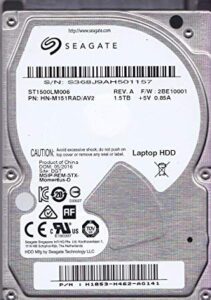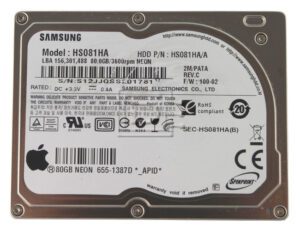 Since 2012, Samsung belongs to Seagate. Seagate has kept some models of Samsung as they are, putting its brand name on the sticker (e.g., HD204UI = ST2000DL004 or ST1500LM005 = HN-M151RAD as seen in the adjacent photo), while others have been completely discontinued.
Since 2012, Samsung belongs to Seagate. Seagate has kept some models of Samsung as they are, putting its brand name on the sticker (e.g., HD204UI = ST2000DL004 or ST1500LM005 = HN-M151RAD as seen in the adjacent photo), while others have been completely discontinued.
However, the technology and architecture of these drives remain Samsung’s.
The most classic problem these drives show is stiction. When this failure occurs, the heads of the drive stick to the surface of the drive, and the drive cannot spin. Characteristically, a buzz is heard from the inside of the drive, indicating its attempt to start. Listen to the sound here.
If your drive suffers from stiction, DO NOT try to repair it yourself and do not follow advice from people who are not knowledgeable.
We have countless examples where advice like “tap it lightly with a hammer“, “let it fall on a carpet“, “put the drive in the freezer“, and other such nonsense resulted in making recovery more expensive or impossible.
Another frequent (and serious) problem that Samsung drives present is firmware failures. The firmware is stored on the platters in the so-called Service Area of these drives. If one of the critical modules cannot be read by the drive, it cannot start and will remain in a BUSY (“HALT”) state.
There is no way to address this problem without using specialized equipment, and it is absolutely necessary that all actions are performed by trained personnel with deep knowledge of hard drives and data recovery.
Otherwise, there is a serious possibility that damage will be caused to the drive’s firmware to an extent that it will be very difficult to restore, even by us.
Another failure that Samsung drives may experience is an electronic error on the board. This usually occurs due to voltage fluctuations or motor issues in the drive. If this happens, the drive does not start and – naturally – is not recognized at all in BIOS.

If the Samsung hard drive makes a clicking sound at startup, it is most often a sign of damaged heads. In this case, it is very important to perform proper diagnostics to determine the extent of the damage.
Finally, a classic problem of these drives (as well as all other drives from all manufacturers) is Bad Sectors. After a certain period, the platters where data is written begin to degrade (“degradation“) and bad sectors appear.
When the drive tries to read such areas of the surface, it may freeze or make strange noises such as “scratching,” light ticks, or loud noises.
Once the drive starts showing such symptoms, it is very important to immediately stop the drive and submit it for a free diagnosis.
Any further attempts you make will add to the problems the drive already has and reduce the number of recoverable data.

